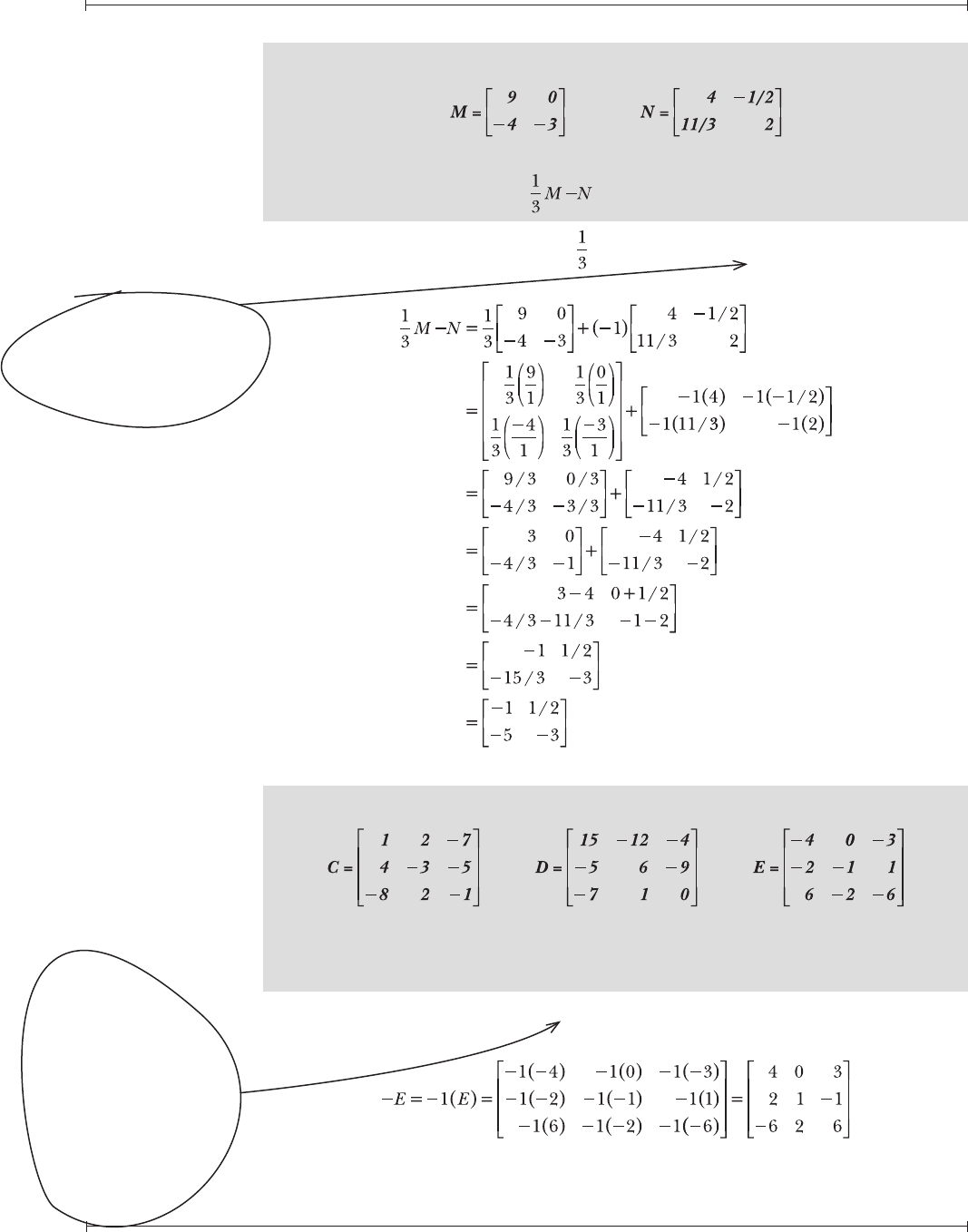
Chapter Nine — Matrix Operations and Calculations
The Humongous Book of Algebra Problems
183
Note: Problems 9.4–9.6 refer to matrix B defined below and the elements b
ij
of matrix B.
9.4 What is the order of the matrix?
Matrix B has three horizontal rows and three vertical columns, so it has order
3 × 3. Because B is a square matrix (a matrix with an equal number of rows and
columns), you can describe its order using a single number: 3.
Note: Problems 9.4–9.6 refer to matrix B defined below and the elements b
ij
of matrix B.
9.5 Identify element b
23
.
Element b
23
is in the second row (from the top) and the third column (from the
left) of matrix B: b
23
= –5.
Note: Problems 9.4–9.6 refer to matrix B defined below and the elements b
ij
of matrix B.
9.6 Identify element b
31
.
Element b
31
is in the third row (from the top) and the first column (from the
left) of matrix B: b
31
= 3.
Adding and Subtracting Matrices
Combine numbers in matching positions
9.7 What condition must be met by matrices A and B if the matrix C = A + B exists?
Matrix C is defined as the sum of matrices A and B, and a matrix sum (or
difference) is defined only for matrices of the same order.
You can
only use a
single number to
describe the order of
a matrix if the matrix
is square. The order
of any other matrix
looks like r × c.
You can
only add
or subtract
matrices if
they’re the same
size. In other words,
they need a matching
number of rows and a
matching number of
columns. You can’t add
a 3 × 2 matrix to a 2
× 3 matrix, but you
can add two 3 × 2
matrices or two
2 × 3 matrices
together.

Chapter Nine — Matrix Operations and Calculations
The Humongous Book of Algebra Problems
184
9.8 Calculate the sum of the matrices: .
Both row matrices are the same size (that is, they have the same order) so the
matrix sum is defined and has the same order: 1 × 3. To calculate the sum, add
elements in corresponding positions.
9.9 Calculate the sum of the matrices: .
Both matrices have the same order (2 × 2) so the sum exists and is also a 2 × 2
matrix. To calculate the sum, add elements in corresponding positions.
Note: Problems 9.10–9.11 refer to matrices A and B defined below.
9.10 Perform scalar multiplication to calculate 4A and 3B.
To generate 4A, multiply each element of A by 4; to generate 3B, multiply each
element of B by 3.
A matrix like this
one that has only one
row is called a “row
matrix.” If a matrix
has only one column, it’s
called either a “column
matrix” or a “columnar
matrix.”
It’s easy: add
upper-left to upper-
left (13 + 12), upper-
right to upper-right
(–5 + [–3]), lower-left to
lower-left (–7 + 8), and
lower-right to lower-
right (2 + [–1]).
A scalar is
a real number
that’s multiplied
by every term in
a matrix. It’s like
the distributive
property, but
on a bigger
scale.

Chapter Nine — Matrix Operations and Calculations
The Humongous Book of Algebra Problems
185
Note: Problems 9.10–9.11 refer to matrices A and B defined below.
9.11 Evaluate the expression: 4A + 3B.
According to Problem 9.10, and . Calculate
the sum by adding elements in corresponding positions.
Note: Problems 9.12–9.13 refer to matrices M and N defined below.
9.12 Evaluate the expression: 2M + 3N.
Multiply each element of M by 2, multiply each element of N by 3, and then add
the resulting matrices.
Textbooks
often write
fractions with
the numerator
and denominator
next to each other
(instead of above
and below each
other) when they’re
inside matrices. Even
though they look
a little strange,
they’re just
ordinary
fractions.

Chapter Nine — Matrix Operations and Calculations
The Humongous Book of Algebra Problems
186
Note: Problems 9.12–9.13 refer to matrices M and N defined below.
9.13 Evaluate the expression: .
Multiply each element of M by and each element of N by –1. Add the resulting
matrices.
Note: Problems 9.14–9.15 refer to matrices C, D, and E defined below.
9.14 Evaluate the expression: C + D – E.
Note that C + D – E = C + D + (–E). Perform scalar multiplication to generate
matrix –E.
Evaluate the expression C + D + (–E).
The expression
contains “–N”, which is
the same thing as “–1N.”
Subtracting
matrix E is
the same thing as
adding –E. That’s
why you spend the
rst part of this
problem guring
out what –E is.

Chapter Nine — Matrix Operations and Calculations
The Humongous Book of Algebra Problems
187
Note: Problems 9.14–9.15 refer to matrices C, D, and E defined below.
9.15 Evaluate the expression: 3C – 2D + 4E.
Perform scalar multiplication to generate matrices 3C, –2D, and 4E. Add the
resulting matrices.
..................Content has been hidden....................
You can't read the all page of ebook, please click here login for view all page.
